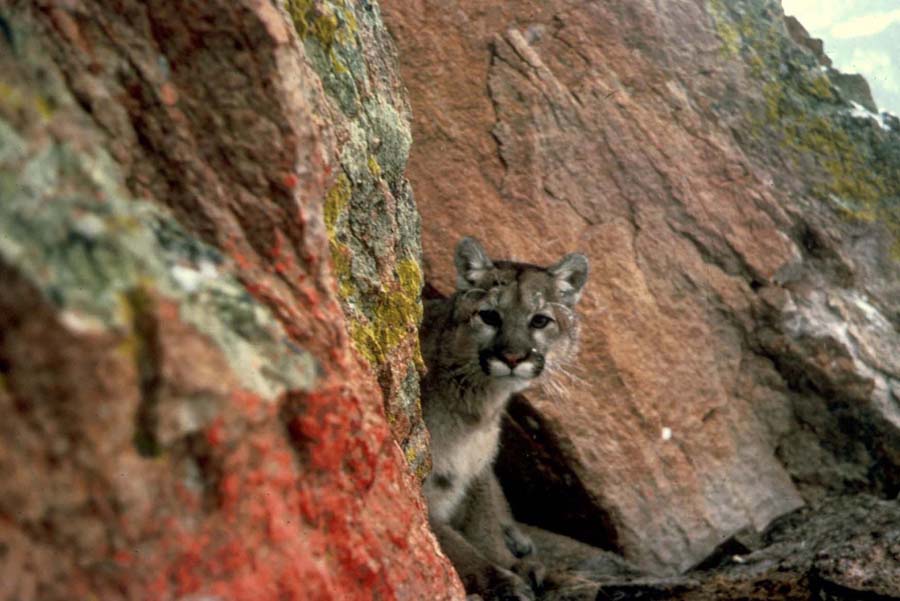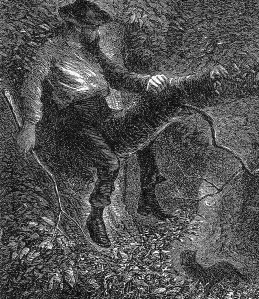
By M. Mark Miller
Probably the best known story of early travel to Yellowstone Park is Truman Everts’ account of being lost and alone there for 37 days. During the famous Washburn Expedition of 1870, Everts became separated from his companions as they made their way through heavy timber east of Lake Yellowstone. Everts was extremely nearsighted, so he got off his horse to look for tracks. While he was scrutinizing a path, the horse ran away, leaving him with little but the clothing on his back.
Everts was a clever and tenacious man. He built a nest between two hot springs to survive a snow storm, made fire with the lens from an opera glass, and lived mostly on a diet of thistle roots.
He told about his adventures in a magazine article that helped win support for creation of Yellowstone Park. Here’s one of those adventures:
I stretched myself under a tree, and fell asleep. How long I slept I know not; but suddenly I was roused by a loud, shrill scream, like that of a human being in distress. There was no mistaking that fearful voice. It was the screech of a mountain lion; so alarmingly near as to cause every nerve to thrill with terror.

The work of the moment was to yell in return—seize with convulsive grasp the limbs of the friendly tree—and swing myself into it. Scrambling hurriedly from limb to limb, I was soon as near the top as safety would permit.
The savage beast was snuffing and growling below—on the very spot I had just abandoned. I answered every growl with a responsive scream. Terrified at the delay and pawing of the beast, I increased my voice to its utmost volume. I then broke branches from the limbs and madly hurled them at the spot from whence the howlings preceded.
I failed to alarm the animal that now began to make the circuit of the tree—as if to select a spot for springing into it. With my strength increased by terror, I shook the slender trunk until every limb rustled. All in vain. The terrible creature pursued his walk around the tree—lashing the ground with his tail, and prolonging his howling almost to a roar.
It was too dark to see, but the movements of the lion kept me apprised of its position. Whenever I heard it on one side of the tree, I speedily changed to the opposite—an exercise that I could only have performed under the impulse of terror. I would alternately sweat and thrill with horror at the thought of being torn to pieces—and devoured by this formidable monster. All my attempts to frighten it seemed unavailing.
Disheartened at its persistency, and expecting at every moment that it would take the deadly leap. I tried to collect my thoughts, and prepare for the fatal encounter. Just at this moment it occurred to me that I would try silence. Clasping the trunk of the tree with both arms, I sat perfectly still.
 The lion ranged around, occasionally snuffing and pausing—all the while filling the forest with the echo of his howling. Suddenly it imitated my example and fell silent. This was more terrible than the clatter and crash of his movements through the brushwood. Now I did not know from what direction to expect this attack. Moments passed with me like hours. After a lapse of time, which I cannot estimate, the beast gave a spring into the thicket and ran screaming into the forest. My deliverance was effected.
The lion ranged around, occasionally snuffing and pausing—all the while filling the forest with the echo of his howling. Suddenly it imitated my example and fell silent. This was more terrible than the clatter and crash of his movements through the brushwood. Now I did not know from what direction to expect this attack. Moments passed with me like hours. After a lapse of time, which I cannot estimate, the beast gave a spring into the thicket and ran screaming into the forest. My deliverance was effected.
Had strength permitted, I should have retained my perch till daylight. But with the consciousness of escape from the jaws of the ferocious brute came a sense of overpowering weakness. That made my descent from the tree both difficult and dangerous. Incredible as it may seem, I lay down in my old bed, and was soon lost in a slumber so profound that I did not awake until after daylight.
Excerpt and illustration from Truman Everts’ “Thirty-Seven Days of Peril,” Scribner’s Monthly, 3(1):1-17 (November 1871).
Reprinted with permission from M. Mark Miller. The complete Truman Everts Yellowstone mountain lion story is available in Miller’s, Adventures in Yellowstone: Early Travelers Tell Their Tales.
